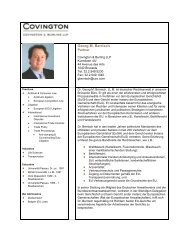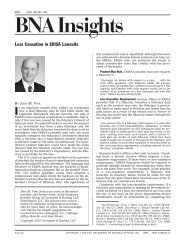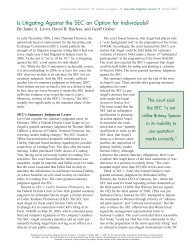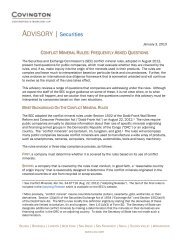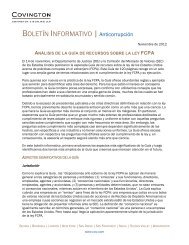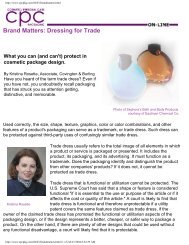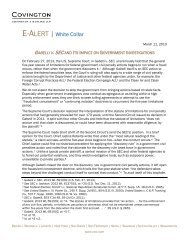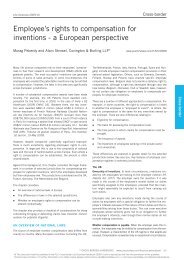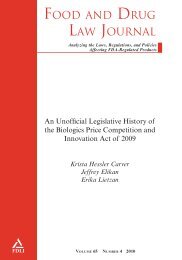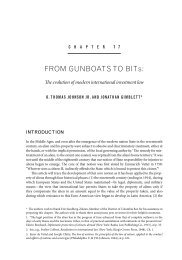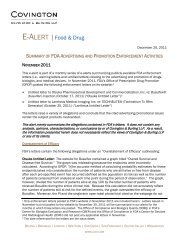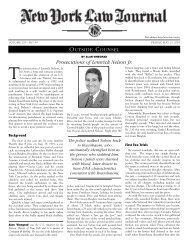Summary of FDA Advertising and Promotion Enforcement Activities
Summary of FDA Advertising and Promotion Enforcement Activities
Summary of FDA Advertising and Promotion Enforcement Activities
You also want an ePaper? Increase the reach of your titles
YUMPU automatically turns print PDFs into web optimized ePapers that Google loves.
COVINGTON & BURLING LLP<br />
Unsubstantiated Claims / Unsubstantiated Superiority Claim: The article detailer included, among<br />
other things, the following statements about the effectiveness <strong>of</strong> three different drugs (including<br />
cozapine) on five symptom “clusters” associated with schizophrenia:<br />
• “Treatment with the three atypical agents studied (clozapine, olanzapine, <strong>and</strong> risperidone) was<br />
associated with significant improvements in 3 <strong>of</strong> 5 PANSS symptom clusters (positive, cognitive,<br />
depression/anxiety). Clozapine <strong>and</strong> olanzapine showed improvement in the negative cluster.<br />
Only clozapine was associated with significant improvement in the excitement symptom<br />
cluster.” 2<br />
• “Both clozapine <strong>and</strong> olanzapine improved the negative symptom cluster in a similar manner.” 3<br />
• “Clozapine, olanzapine, <strong>and</strong> risperidone all significantly improved the positive, cognitive, <strong>and</strong><br />
depression/anxiety symptom clusters.” 4<br />
• “The excitement domain findings <strong>of</strong> this study ‘further point to clozapine’s efficacy for patients<br />
having difficulty with aggression <strong>and</strong> impulse control.’” 5<br />
OPDP alleged that these claims are misleading because they “imply that clozapine demonstrated<br />
significant efficacy in treating four <strong>of</strong> the five ‘symptom clusters’ associated with schizophrenia …<br />
when this has not been demonstrated by substantial evidence or substantial clinical experience.”<br />
<strong>FDA</strong> noted that the claims were based on a retrospective, Positive <strong>and</strong> Negative Syndrome Scale<br />
(“PANSS”) derived five-factor analysis <strong>of</strong> data from a previously published prospective, r<strong>and</strong>omized,<br />
14-week clinical trial. <strong>FDA</strong> stated that this type <strong>of</strong> retrospective analysis does not constitute<br />
substantial evidence or substantial clinical experience <strong>and</strong> thus cannot be used to support the<br />
claims.<br />
Furthermore, OPDP stated that the claims “Clozapine was superior to both risperidone <strong>and</strong><br />
haloperidol in treating the excitement cluster” <strong>and</strong> “[o]nly clozapine was associated with<br />
improvement in the excitement domain,” 6 in conjunction with the comparative graphic presentation<br />
detailing the results <strong>of</strong> the PANSS-derived five factor analysis, misleadingly suggest that clozapine is<br />
superior to the other drugs studied in the excitement symptom cluster. OPDP noted that a single<br />
retrospective analysis is not considered substantial evidence or substantial clinical experience to<br />
support the “implication” <strong>of</strong> superiority for clozapine. Instead, OPDP stated that a head-to-head<br />
study is required.<br />
Omission <strong>and</strong> Minimization <strong>of</strong> Risk Information: OPDP also stated that the article detailer failed to<br />
disclose (1) that clozapine is contraindicated in patients with hypersensitivity to clozapine or any<br />
other component <strong>of</strong> the drug; <strong>and</strong> (2) numerous risks associated with clozapine such as QT interval<br />
prolongation, fever, <strong>and</strong> hepatitis (among others). OPDP noted that while the article detailer<br />
included limited information regarding QT interval prolongation, it failed to mention that clozapine<br />
treatment should be discontinued if the QTc interval exceeds 500 milliseconds, as stated in the<br />
approved label.<br />
OPDP also alleged that the article detailer misleadingly presented numerous efficacy claims by using<br />
colorful pictures, graphics, <strong>and</strong> large bolded headers surrounded by white space, while providing risk<br />
information in smaller print <strong>and</strong> in block paragraph format on the back page. Although, OPDP noted<br />
that the article detailer included the bolded statement “Please see back cover for additional<br />
2 Emphasis in article detailer.<br />
3 Emphasis in article detailer.<br />
4 Emphasis in article detailer.<br />
5 Emphasis in article detailer.<br />
6 Emphasis in article detailer.<br />
C&B<br />
2



